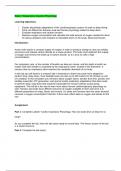Other
BIOS 255 Week 7 Respiratory System Physiology LAB 2024
- Module
- BIOS 255 (BIOS255)
- Institution
- Abacus College, Oxford
BIOS 255 Week 7 Respiratory System Physiology LAB 2024/BIOS 255 Week 7 Respiratory System Physiology LAB 2024/BIOS 255 Week 7 Respiratory System Physiology LAB 2024/BIOS 255 Week 7 Respiratory System Physiology LAB 2024
[Show more]



